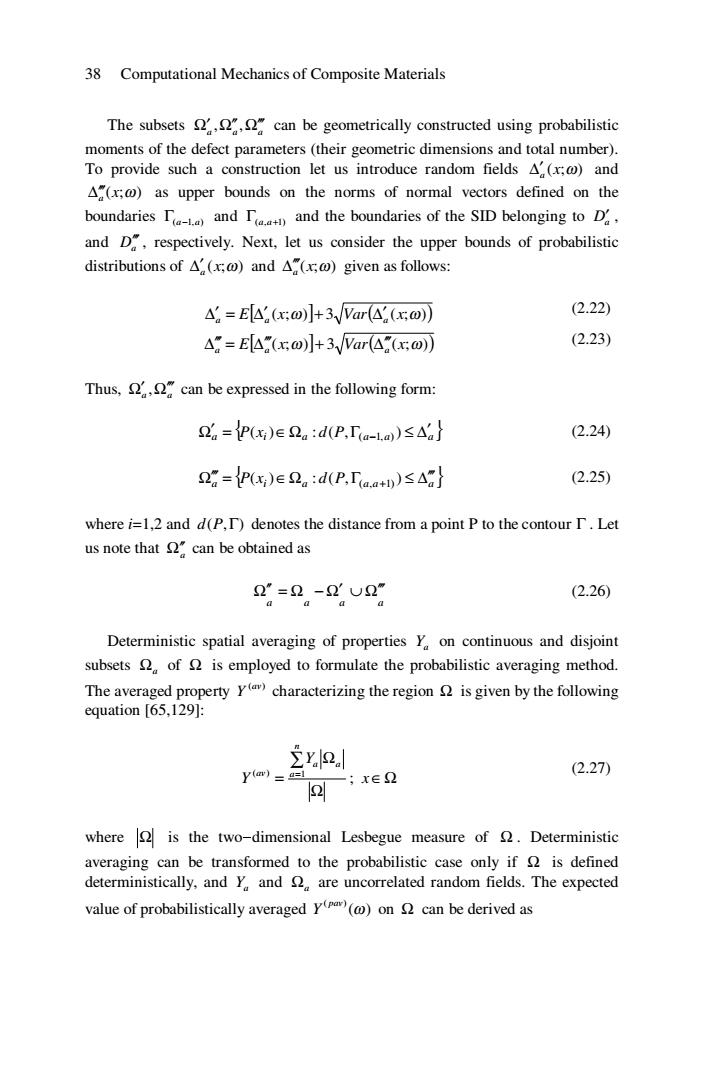正在加载图片...

38 Computational Mechanics of Composite Materials The subsets can be geometrically constructed using probabilistic moments of the defect parameters(their geometric dimensions and total number). To provide such a construction let us introduce random fields A(x@)and A(x;@)as upper bounds on the norms of normal vectors defined on the boundaries T and I and the boundaries of the SID belonging to D, and D respectively.Next,let us consider the upper bounds of probabilistic distributions of A(x)and A()given as follows: △=EA(x:o)]+3 Var(A(xo】 (2.22) △=EA(xo)]+3VarA(xo)】 (2.23) Thus,can be expressed in the following form: 2a=P(x)e2a:d(P,ra-la)≤△a} (2.24) 2a=P()e2a:d(P,「a.a+l)≤△g (2.25) where i=1,2 and d(P,T)denotes the distance from a point P to the contour T.Let us note that can be obtained as 2°=2-2'U2 (2.26) Deterministic spatial averaging of properties Y on continuous and disjoint subsets of is employed to formulate the probabilistic averaging method. The averaged property Y(characterizing the region is given by the following equation [65,129]: y. y(@)=a=1 (2.27) ;x∈2 whereis the two-dimensional Lesbegue measure of Deterministic averaging can be transformed to the probabilistic case only if is defined deterministically,and Y and are uncorrelated random fields.The expected value of probabilistically averaged (@)on can be derived as38 Computational Mechanics of Composite Materials The subsets a a Ωa Ω′ , can be geometrically constructed using probabilistic Ω′′, ′′′ moments of the defect parameters (their geometric dimensions and total number). To provide such a construction let us introduce random fields ) ∆′ a (x;ω and (x;ω) ∆a ′′′ as upper bounds on the norms of normal vectors defined on the boundaries Γ(a −1,a) and Γ(a,a+1) and the boundaries of the SID belonging to Da ′ , and Da ′′′ , respectively. Next, let us consider the upper bounds of probabilistic distributions of ) ∆′ a (x;ω and ) ∆′ a ′′(x;ω given as follows: E[ ] (x;ω) 3 Var( ) (x;ω) a a ∆a ∆′ = ∆′ + ′ (2.22) E[ ] (x;ω) 3 Var( ) (x;ω) a a ∆a ∆′′′ = ∆′′′ + ′′′ (2.23) Thus, a Ωa Ω′ , can be expressed in the following form: ′′′ Ω′ a = {P(xi)∈Ωa : d(P,Γ(a−1,a) ) ≤ ∆′ a } (2.24) Ω′ a ′′ = {P(xi)∈Ωa : d(P,Γ(a,a+1) ) ≤ ∆′ a ′′} (2.25) where i=1,2 and ) d(P,Γ denotes the distance from a point P to the contour Γ . Let us note that Ωa ′′ can be obtained as a a a a Ω′′ = Ω − Ω′ ∪ Ω′′′ (2.26) Deterministic spatial averaging of properties Ya on continuous and disjoint subsets Ωa of Ω is employed to formulate the probabilistic averaging method. The averaged property (av) Y characterizing the region Ω is given by the following equation [65,129]: Ω Ω = ∑ = n a a a av Y Y ( ) 1 ; x∈Ω (2.27) where Ω is the two-dimensional Lesbegue measure of Ω . Deterministic averaging can be transformed to the probabilistic case only if Ω is defined deterministically, and Ya and Ωa are uncorrelated random fields. The expected value of probabilistically averaged ) ( ( ) ω pav Y on Ω can be derived as